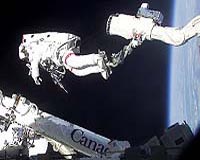 |
Davis CA (SPX) Mar 03, 2010 A new device invented by engineers at UC Davis could make it much faster to convert pulses of light into electronic signals and back again. The technology could be applied to ultrafast, high-capacity communications, imaging of the Earth's surface and for encrypting secure messages. "We have found a way to measure a very high capacity waveform with a combination of standard electronics and optics," said S.J. Ben Yoo, professor of electrical and computer engineering at UC Davis. A paper describing the technology was published Feb. 28 in the journal Nature Photonics. The device is up to 10,000 times faster than existing technologies for measuring light pulses, Yoo said. It overcomes the limitations of existing approaches, by measuring both the amplitude (intensity) and the phase of a pulse at the same time, and can measure information capacity into the 100 terahertz range in real time. Current electronics are limited to information capacity in tens of gigahertz bandwidth. Higher-frequency pulses can pack more information into a given length of time. By making it possible to take a complex waveform and quickly decode it into a digital electronic signal, the device would make it possible to pack more data into optical signals. Operated in reverse, the same kind of device could be used to generate optical signals from electronics. The device - developed by Yoo's UC Davis research group, including graduate student Nicolas Fontaine; postdoctoral researchers Ryan Scott, Linjie Zhou and Francisco Soares; and Professor Jonathan Heritage - divides the incoming signal into slices of frequency spectrum, processes the slices in parallel and then integrates them. The technology could be used in ultra-high-speed communications and also in LiDAR (light detection and ranging) systems. LiDAR uses pulses of laser light to rapidly scan the landscape and produce highly detailed, three-dimensional images of the Earth's surface. The next step is to work on putting the whole device into a small silicon chip, Yoo said.
Share This Article With Planet Earth
Related Links UC Davis Space Technology News - Applications and Research
 Canada to boost space research
Canada to boost space researchOttawa (AFP) March 3, 2010 The Canadian government is to boost its support for research of space technologies, Governor General Michaelle Jean said Wednesday in a speech to open parliament. "Canada has been a space faring nation for 50 years," Jean said in the Speech from the Throne - an address that traditionally opens every session of the Canadian parliament. "Our government will extend support for advanced res ... read more |
|
| The content herein, unless otherwise known to be public domain, are Copyright 1995-2010 - SpaceDaily. AFP and UPI Wire Stories are copyright Agence France-Presse and United Press International. ESA Portal Reports are copyright European Space Agency. All NASA sourced material is public domain. Additional copyrights may apply in whole or part to other bona fide parties. Advertising does not imply endorsement,agreement or approval of any opinions, statements or information provided by SpaceDaily on any Web page published or hosted by SpaceDaily. Privacy Statement |